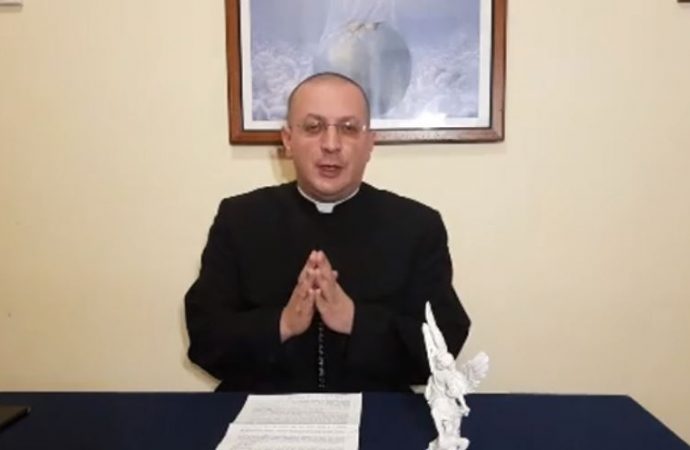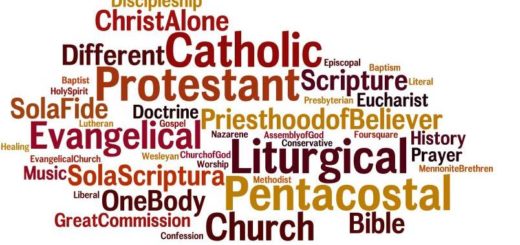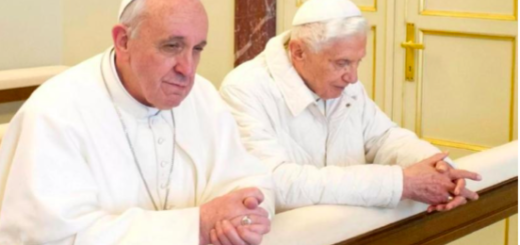Italian priest’s attack on Francis draws attention to clergy’s use of social media

CRUX
Editorial Assistant
Nov 17, 2017
Father Alessandro Minutella appears in a video on Radio Domina Nostra’s Facebook page, where he refuses to pledge obedience to Pope Francis. (Credit: Facebook)
 The case of a Sicilian priest who used social media to attack Pope Francis has drawn attention to current tensions inside the Church and the way clergy use new media. Father Alessandro Minutella has refused his archbishop's demand to declare his loyalty to the pope, and instead announced on social media his opposition to "the so-called Church of Mercy." One leading official in Church communications said priests should not be using social media to promote "their own particular agenda." Division is nothing new in the Vatican, but Pope Francis’ reform and openness to change has generated consistent backlash. The latest public declaration of dissent comes from the pope’s own backyard. However, credit for this must go to the Pope for not suppresing dissenting voices so that he can gauge the ground reality and to read the signs of the times. Also it is very difficult for the Italian clergy to accept an outsider (non-Italian) as their Pope. They are so used to ruling the roost for ages! Isaac Gomes, Asso. Editor, Church Citizens' Voice.
The case of a Sicilian priest who used social media to attack Pope Francis has drawn attention to current tensions inside the Church and the way clergy use new media. Father Alessandro Minutella has refused his archbishop's demand to declare his loyalty to the pope, and instead announced on social media his opposition to "the so-called Church of Mercy." One leading official in Church communications said priests should not be using social media to promote "their own particular agenda." Division is nothing new in the Vatican, but Pope Francis’ reform and openness to change has generated consistent backlash. The latest public declaration of dissent comes from the pope’s own backyard. However, credit for this must go to the Pope for not suppresing dissenting voices so that he can gauge the ground reality and to read the signs of the times. Also it is very difficult for the Italian clergy to accept an outsider (non-Italian) as their Pope. They are so used to ruling the roost for ages! Isaac Gomes, Asso. Editor, Church Citizens' Voice.
ROME – A recent case of an Italian priest asked to leave his parish due to outspoken remarks against Pope Francis and his unconventional practices, highlights the current polarization among some factions of the Church as well as the power of social media to amplify and foment it.
Division is nothing new in the Vatican, but Pope Francis’ reform and openness to change has generated consistent backlash. His document on the family, Amoris Laetitia, which cautiously opened up to the possibility of communion for the divorced and remarried, was met with criticism. In early November, a theological adviser to the U.S. bishops’ conference, Thomas Weinandy, released a letter accusing the pope of causing “chronic confusion.”
The latest public declaration of dissent comes from the pope’s own backyard, more precisely in the Southern Italian city of Palermo, where Father Alessandro Minutella, of the southern Italian city of Palermo, recently published a video on social media where he refused to declare loyalty to the pope as requested by his bishop.
The first warning in Monreale
Minutella had gotten in trouble in the nearby Archdiocese of Monreale – a city just a few miles from Palermo in Sicily. Back in 2015, Monreale’s Archbishop Michele Pennisi disciplined him due to his comments against the pope, and because he claimed to speak on behalf of the Virgin Mary.
His odd practices and the fact that he presented himself as a prophet, led the archbishop to condemn his functions as “contrary to the will of the Church,” and aimed at “manipulating consciences.”
Minutella had even created an order of nuns without authorization, and claimed he and his followers had dug out a well of miraculous water. At the time, Pennisi warned faithful that whoever “supports his activities and collaborates with him [Minutella] is at serious risk for the safety of his soul.”
Minutella is sent away from his parish
At his new parish of San Giovanni Bosco in Palermo, the priest continued to speak his mind and claimed to communicate with Saint Joseph, Mary, and the Archangel Michael, drawing large crowds to his Masses where he declared his intention to defend the Church from heresy.
On his social media accounts, Minutella said his goal was to stand up against “the imposture of the false Church” of Pope Francis.
This was the last straw for the Archbishop of Palermo, Corrado Lorefice, who in a letter dated April 1, asked Minutella to step down from his role as parish priest, as well as no longer post on social media or speak to reporters.
“Your recent remarks on social networks, which reached beyond the confines of our diocese, have provoked a substantial amount of confusion and scandal in the holy people of God,” the archbishop wrote. “It’s in the public domain that both with your words and actions you have to this day not hesitated to take a position of strong dissent and clear opposition toward the Catholic hierarchy with at its head the current Roman pontiff as well as toward your bishop.”
Minutella reacted with outrage, promising his flock his intention not to leave the parish and inviting them to pray for Emeritus Pope Benedict XVI. He even called like minded faithful to meet in Verona on April 22 to “resist” the current pontificate and defend the “true Church.”
The social media Mass
Despite the interdiction by the archbishop, the priest resorted to social media in order to express his dissent with the decision. In a ‘Mass-show’ posted live on Facebook, the priest criticized the bishop and the church. “We will go to the cellars and the catacombs,” he said from the pulpit. “I am the first priest to be condemned, but also to wish to react. I do not fear their manoeuvres and I don’t find them to be efficient.”
Many displayed solidarity toward Minutella, including the parish council, which organized a prayer vigil for him. The local newspapers documented the reaction in the pews, with some describing his words as “a bit close-minded, a bit excessive,” while others praised his comments and expressed a growing concern with a Church that they believe is getting “close to Lutheranism, maybe a little too close.”
One local reporter managed to stop him and interview him as he left the Mass. “Who am I to threaten a schism? We notice that there is a possible schism already happening within the Church,” Minutella told the journalist. “I think it’s time to clarify and affirm traditional values. We see a drift toward Lutheranism.”
Minutella refuses to declare loyalty to Pope Francis
Months of silence followed the social media Mass that shook Palermo. On Sep. 21, Minutella, having petitioned the Congregation for the Clergy at the Vatican, sent a letter to the archbishop, once more expressing his point of view and the reasons that motivated his protest. In the letter the priest professed his obedience to the Roman pontiff, though he did not specify the pope’s name.
Lorefice answered by telling him that his petition had been postponed and that he had to make a public declaration of fealty to Francis on social media. In response, Minutella published a 20 minute video on the Facebook page of Radio Domina Nostra on Nov. 10, where he refused to pledge allegiance to the pope, calling the request “blackmail” and asking Francis to explain his thoughts on Communion for the divorced and remarried.
In the video, the priest also said that he is no longer in ecclesial communion with the Church.
“The strange hierarchy of the so-called Church of Mercy strikes those who do not conform, put at the guillotine those who do not agree with their beliefs,” the priest said.
Pope Francis addressed ‘Amoris’ with Italian bishops
One day after Minutella’s rant on video, Francis spoke about Amoris Laetitiain a video addressing a conference organized by Italian bishops on the subject.
“The contemporary world risks confusing the primacy of conscience, which must always be respected, with the exclusive autonomy of the individual toward the relationships he experiences,” Francis warned Nov. 11. “This point of view is not harmless: It creates a subject that always looks itself in the mirror, until it becomes unable to turn its eyes toward others and the world.
“We are called to inform consciences, not presume to substitute them,” he concluded.
Social media: A powerful tool, a powerful weapon
Beyond bringing attention to the current tensions and divisions within the Catholic Church, the events surrounding Minutella also highlight the power that social media has to amplify and even promote division.
“As with any other media, [social media] is a tool that can be used to bring people together or it can be used unfortunately, in what I would term destructive means,” Helen Osman, president of the World Catholic Association for Communication or Signis, told Crux in an interview.
“One of the best attributes of social media is its ability to allow people to dialogue,” she said, pointing to the fact that the Internet can be a powerful tool for evangelization and catechesis. “To use it as a megaphone for whatever purpose is not to use it according to its natural, organic nature.”
Relating her personal experiences with priests who have used social media to engage and participate with members of their parish and community, Osman said there are possibilities for this medium that go beyond the desire to express one’s personal opinion.
“I’m not sure priests should necessarily be using [social media] to be promoting their own particular agenda,” she said. “Maybe they should be using it to be listening to their parishioners and the people who are immediately under their pastoral care.”
Osman also stressed today’s need for formation and education regarding social media, not only for the clergy but also for lay people and especially parents.
















